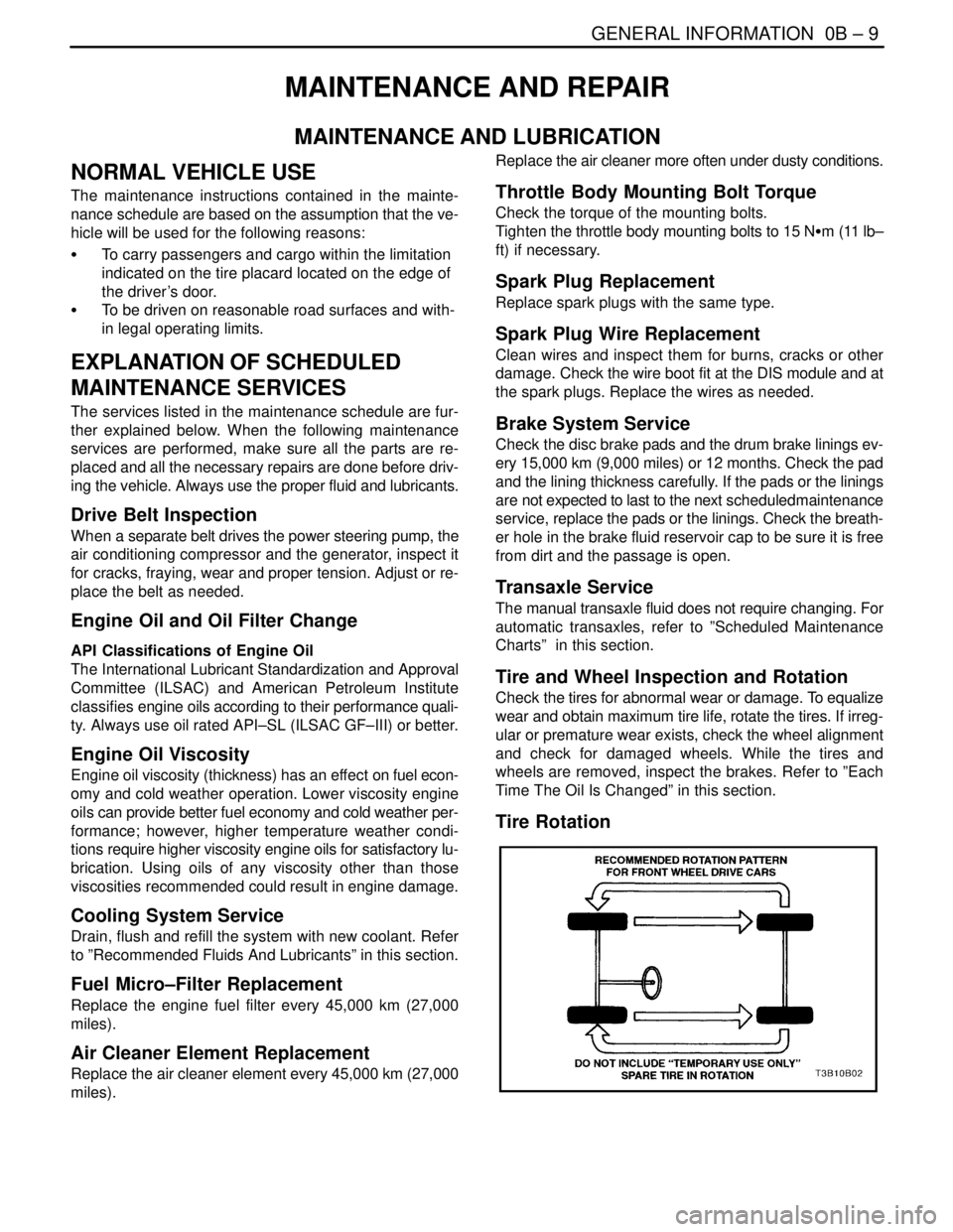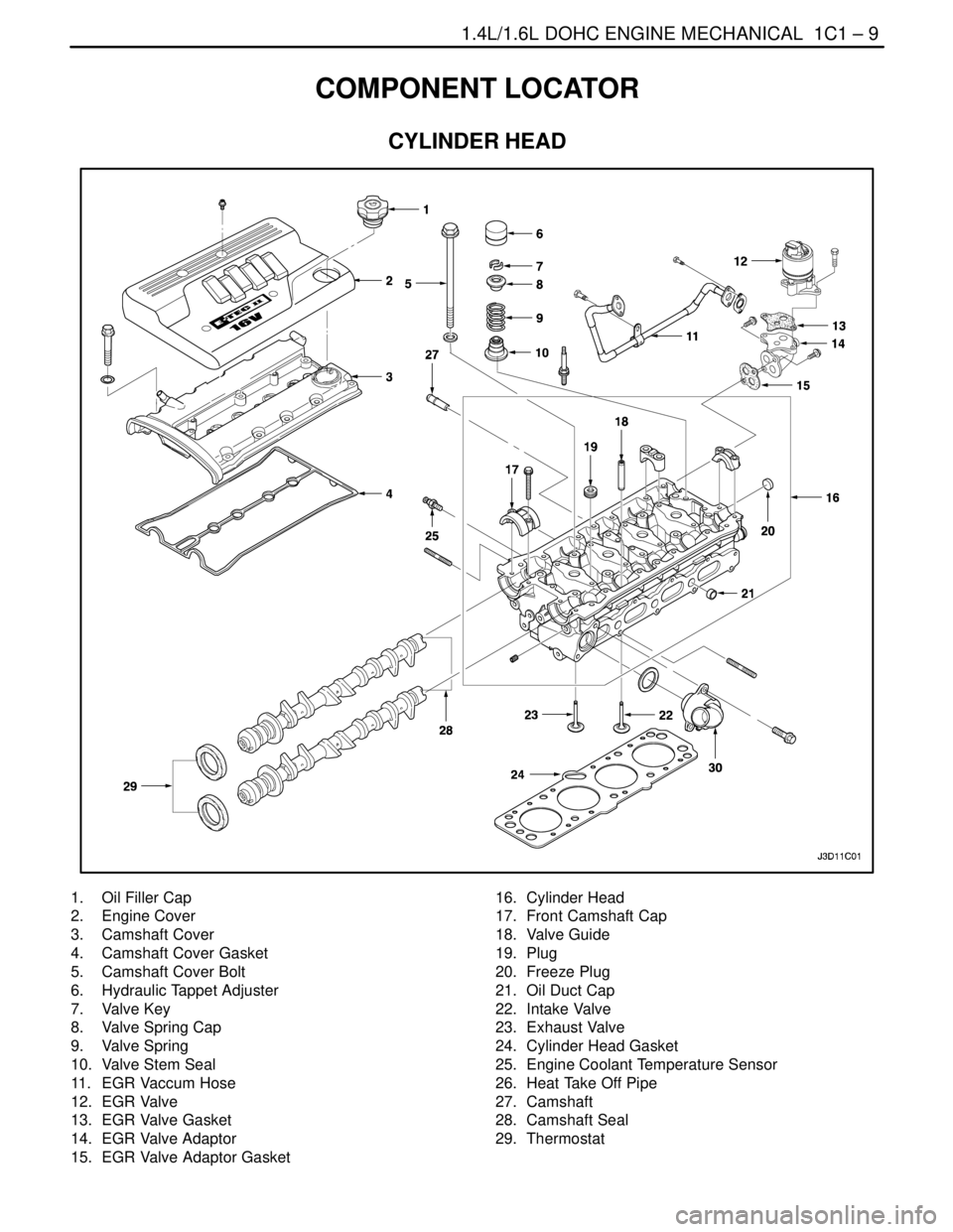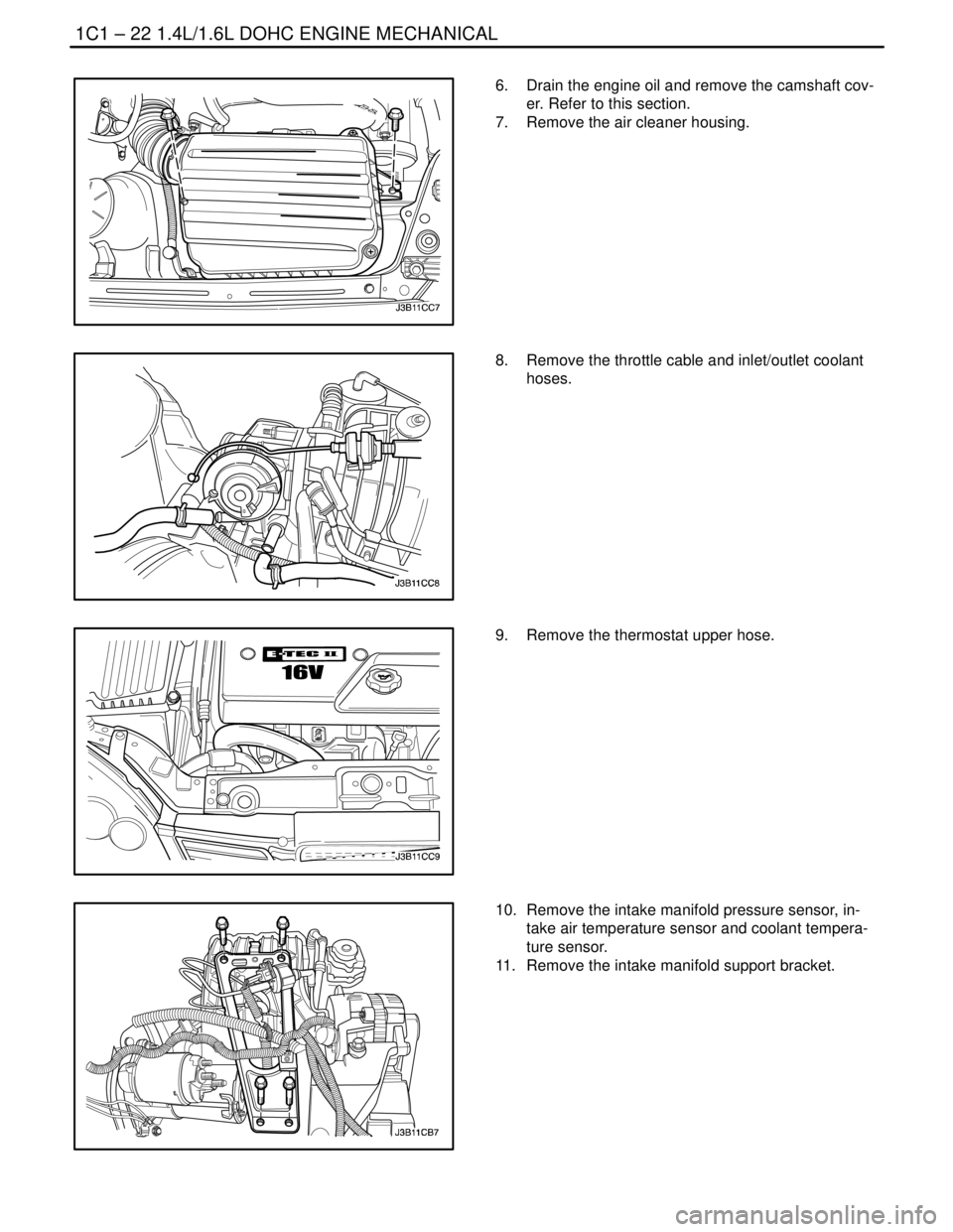oil temperature DAEWOO LACETTI 2004 Service Repair Manual
[x] Cancel search | Manufacturer: DAEWOO, Model Year: 2004, Model line: LACETTI, Model: DAEWOO LACETTI 2004Pages: 2643, PDF Size: 80.54 MB
Page 16 of 2643

GENERAL INFORMATION 0B – 9
DAEWOO V–121 BL4
MAINTENANCE AND REPAIR
MAINTENANCE AND LUBRICATION
NORMAL VEHICLE USE
The maintenance instructions contained in the mainte-
nance schedule are based on the assumption that the ve-
hicle will be used for the following reasons:
S To carry passengers and cargo within the limitation
indicated on the tire placard located on the edge of
the driver’s door.
S To be driven on reasonable road surfaces and with-
in legal operating limits.
EXPLANATION OF SCHEDULED
MAINTENANCE SERVICES
The services listed in the maintenance schedule are fur-
ther explained below. When the following maintenance
services are performed, make sure all the parts are re-
placed and all the necessary repairs are done before driv-
ing the vehicle. Always use the proper fluid and lubricants.
Drive Belt Inspection
When a separate belt drives the power steering pump, the
air conditioning compressor and the generator, inspect it
for cracks, fraying, wear and proper tension. Adjust or re-
place the belt as needed.
Engine Oil and Oil Filter Change
API Classifications of Engine Oil
The International Lubricant Standardization and Approval
Committee (ILSAC) and American Petroleum Institute
classifies engine oils according to their performance quali-
ty. Always use oil rated API–SL (ILSAC GF–III) or better.
Engine Oil Viscosity
Engine oil viscosity (thickness) has an effect on fuel econ-
omy and cold weather operation. Lower viscosity engine
oils can provide better fuel economy and cold weather per-
formance; however, higher temperature weather condi-
tions require higher viscosity engine oils for satisfactory lu-
brication. Using oils of any viscosity other than those
viscosities recommended could result in engine damage.
Cooling System Service
Drain, flush and refill the system with new coolant. Refer
to ”Recommended Fluids And Lubricants” in this section.
Fuel Micro–Filter Replacement
Replace the engine fuel filter every 45,000 km (27,000
miles).
Air Cleaner Element Replacement
Replace the air cleaner element every 45,000 km (27,000
miles).Replace the air cleaner more often under dusty conditions.
Throttle Body Mounting Bolt Torque
Check the torque of the mounting bolts.
Tighten the throttle body mounting bolts to 15 NSm (11 lb–
ft) if necessary.
Spark Plug Replacement
Replace spark plugs with the same type.
Spark Plug Wire Replacement
Clean wires and inspect them for burns, cracks or other
damage. Check the wire boot fit at the DIS module and at
the spark plugs. Replace the wires as needed.
Brake System Service
Check the disc brake pads and the drum brake linings ev-
ery 15,000 km (9,000 miles) or 12 months. Check the pad
and the lining thickness carefully. If the pads or the linings
are not expected to last to the next scheduledmaintenance
service, replace the pads or the linings. Check the breath-
er hole in the brake fluid reservoir cap to be sure it is free
from dirt and the passage is open.
Transaxle Service
The manual transaxle fluid does not require changing. For
automatic transaxles, refer to ”Scheduled Maintenance
Charts” in this section.
Tire and Wheel Inspection and Rotation
Check the tires for abnormal wear or damage. To equalize
wear and obtain maximum tire life, rotate the tires. If irreg-
ular or premature wear exists, check the wheel alignment
and check for damaged wheels. While the tires and
wheels are removed, inspect the brakes. Refer to ”Each
Time The Oil Is Changed” in this section.
Tire Rotation
Page 18 of 2643

GENERAL INFORMATION 0B – 11
DAEWOO V–121 BL4
Chassis and Body
Maintenance ItemMaintenance Interval
Kilometers or time in months, whichever comes first
x 1,000 km1153045607590105120
x 1,000 miles0.6918273645546372
Months–1224364860728496
Interior air filter (A/C)RRRRRRRR
Exhaust pipes & mountingsIIIIIIII
Brake/Clutch fluid (1) (4)IIRIRIRIR
Front brake pads and discs(3)IIIIIIII
Rear brake pads & discs or drums and
linings (3)IIIIIIII
Parking brakeIIIIIIIII
Brake line and connections (Including
booster)IIIIIIII
Manual Transaxle Oil *(1)IIIIIIII
Automatic transaxle fluid *(1) (5)IIIIIIII
Tighten chassis and underbody bolts
and nutsIIIIIIII
Tire condition and inflation pressureIIIIIIIII
Wheel alignment (2)Inspect when abnormal condition is noted
Steering wheel and linkageIIIIIIII
Power steering fluid & lines* (1)IIIIIIIII
Drive shaft bootsIIIIIIII
Seat belts, buckles and anchorsIIIIIIII
Lubricate locks, hinges and hood
latchIIIIIIII
Chart Symbols:
I – Inspect and if necessary correct, clean, replenish, or adjust.
R – Replace or change:
(1) Refer to Recommended Fluids And Lubricants.
(2) And if necessary, rotate and balance wheels.
(3) More frequent if operated under severe conditions: short distance driving, extensive idling, frequent low–speed oper-
aion in stop and go traffic, or driving in dusty conditions.
(4) Change the brake/clutch fluid every 15,000 km (9,000 miles), if the vehicle is mainly driven under the following severe
conditions: driving in hilly or mountainous terrain, or towing a trailer/caravan frequently.
(5) 1.8 DOHC model (ZF 4HP16 Automatic Transaxle): Change automatic transaxle fluid every 60,000 Km (36,000 miles)
if the vehicle is mainly driven under any of the following severe conditions:
S In heavy city traffic where the outside temperature regularly reaches 32°C (90°F) or higher, or
S In hilly or mountainous terrain, or
S When doing frequent trailer towing, or
S Uses such as taxi, police or delivery service.
Page 21 of 2643

0B – 14IGENERAL INFORMATION
DAEWOO V–121 BL4
Engine Cooling System
Inspect the coolant and freeze protection fluid. If the fluid
is dirty or rusty, drain, flush and refill the engine cooling
system with new coolant. Keep the coolant at the proper
mixture in order to ensure proper freeze protection, corro-sion protection and engine operating temperature. Inspect
the hoses. Replace the cracked, swollen, or deteriorated
hoses. Tighten the clamps. Clean the outside of the radia-
tor and the air conditioning condenser. Wash the filler cap
and the neck. Pressure test the cooling system and the
cap in order to help ensure proper operation.
RECOMMENDED FLUIDS AND LUBRICANTS
UsageCapacityFluid/Lubricant
Engine Oil3.75L (4.0 qt) : 1.4L DOHC
3.75L (4.0 qt) : 1.6L DOHC
4.0L (4.2 qt) : 1.8L DOHCAPI SL (ILSAC GF–III) grade or better
SAE 5W–30, SAE10W–30, SAE15W–40
(Cold area : SAE5W–30
Hot area : SAE 15W–40)
Engine Coolant7.0L (7.49 qt) : 1.4L DOHC
7.2L (7.6 qt) : 1.6L DOHC
7.4L (7.8 qt) : 1.8L DOHCMixture of water and good quality ethylene gly-
col base antifreeze (year–round coolant)
Brake Fluid and Clutch Fluid0.5L (0.5 qt)DOT–3 or DOT–4
Power Steering System1.1L (1.2 qt)DEXRON®–III or DEXRON®–IID
Automatic Transaxle5.77 ± 0.2L (6.1 ± 0.2 qts) :
1.6L DOHC (AISIN 81–40LE)ESSO JWS 3309 or ISU DEXRON III
6.9 ± 0.2L (7.3 ± 0.2 qts) :
1.8L DOHC (ZF 4HP16)ESSO LT 71141 or TOTAL ATF H50235
Manual Transaxle1.8L (2.0 qt)Manual Transaxle Fluid
SAE80W (Cold Area : SAE 75W)
Manual Transaxle Shift LinkageAs requiredMultipurpose type grease meeting require-
ments NLGI No. 1 or 2
Key Lock CylindersAs requiredSilicone lubricant
Automatic Transaxle Shift Link-
ageAs requiredEngine oil
Clutch Linkage Pivot PointsAs requiredEngine oil
Floor Shift Linkage PointsAs requiredEngine oil
Hood Latch Assembly
a. Pivots and Spring Anchor
b. Release PawlAs requireda. Engine oil
b. Multipurpose type grease meeting require-
ments NLGI No. 1 or 2
Hood and door hinges
Fuel door hinge
Rear compartment lid hingesAs requiredEngine oil
WeatherstripsAs requiredSilicone grease
Page 34 of 2643

1A – 2IGENERAL ENGINE INFORMATION
DAEWOO V–121 BL4
OIL PRESSURE TEST
StepActionValue(s)YesNo
1Is the oil pressure warning lamp on?–Go to Step 2System OK
2Check the oil level in the crankcase.
Is the oil level low?–Go to Step 3Go to Step 4
3Add oil so that the oil level is up to the fullmark on the
indicator.
Is the repair complete?–Go to Step 1–
4Check the idle speed.
Is the idle speed below the specified value ?825 rpmGo to Step 5Go to Step 6
5Increase the idle speed.
Is the speed increased?–Go to Step 1–
6Inspect the oil pressure switch.
Is the oil pressure switch incorrect or malfunction-
ing?–Go to Step 7Go to Step 8
7Install a new oil pressure switch.
Is the repair complete?–Go to Step 1–
8Inspect the oil pressure gauge.
Is the oil pressure gauge incorrect or malfunction-
ing?–Go to Step 9Go to Step 10
9Install a new oil pressure gauge.
Is the repair complete?–Go to Step 1–
10Inspect the engine oil.
Is the engine oil in the crankcase diluted or of the im-
proper viscosity?–Go to Step 11Go to Step 12
11Install new engine oil of the proper viscosity for the
expected temperatures.
Is the repair complete?–Go to Step 1–
12Inspect the oil pump.
Is the pump worn or dirty?–Go to Step 13Go to Step 14
13Replace the oil pump.
Is the repair complete?–Go to Step 1–
14Inspect the oil filter.
Is the oil filter plugged?–Go to Step 15Go to Step 16
15Install a new oil filter.
Is the repair complete?–Go to Step 1–
16Inspect the oil pickup screen.
Is the oil pickup screen loose or plugged?–Go to Step 17Go to Step 18
17Tighten or replace the oil pickup screen, as neces-
sary.
Is the repair complete?–Go to Step 1–
18Inspect the oil pickup tube.
Are there any holes in the oil pickup tube?–Go to Step 19Go to Step 20
19Replace the oil pickup tube.
Is the repair complete?–Go to Step 1–
Page 35 of 2643

GENERAL ENGINE INFORMATION 1A – 3
DAEWOO V–121 BL4
StepNo Yes Value(s) Action
20Inspect the bearing clearances.
Are the bearing clearances more than the specified
values?Crankshaft
0.026 ~0.046
mm
(0.0010~0.001
8 in.)
Connecting
Rod 0.019 ~
0.070 mm
(0.0007 ~
0.0027 in.)Go to Step 21Go to Step 22
21Replace the bearing, if necessary.
Is the repair complete?–Go to Step 1–
22Inspect the oil galleries.
Are the oil galleries cracked, porous, or plugged?–Go to Step 23Go to Step 24
23Repair or replace the engine block.
Is the repair complete?–Go to Step 1–
24Inspect the gallery plugs.
Are any of the gallery plugs missing or installed im-
properly?–Go to Step 25Go to Step 26
25Install the plugs or repair, as necessary.
Is the repair complete?–Go to Step 1–
26Inspect the camshaft.
Is the camshaft worn or is there evidence of poor
machining?–Go to Step 27System OK
27Replace the camshaft.
Is the repair complete?–Go to Step 1–
OIL LEAK DIAGNOSIS
Most fluid oil leaks are easily located and repaired by visu-
ally finding the leak and replacing or repairing the neces-
sary parts. On some occasions, a fluid leak may be difficult
to locate or repair. The following procedures may help you
in locating and repairing most leaks.
Finding the Leak:
1. Identify the fluid. Determine whether it is engine oil,
automatic transmission fluid, power steering fluid,
etc.
2. Identify where the fluid is leaking from.
1) After running the vehicle at normal operating
temperature, park the vehicle over a large sheet
of paper.
2) Wait a few minutes.
3) Find the approximate location of the leak by the
drippings on the paper.
3. Visually check around the suspected component.
Check around all the gasket mating surfaces for
leaks. A mirror is useful for finding leaks in areas
that are hard to reach.
4. If the leak still cannot be found, it may be neces-
sary to clean the suspected area with a degreaser,
steam, or spray solvent.
1) Thoroughly clean the area.2) Dry the area.
3) Operate the vehicle for several miles at normal
operating temperature and varying speeds.
4) After operating the vehicle, visually check the
suspected component.
5) If you still cannot locate the leak, try using the
powder or black light and dye method.
Powder Method:
1. Clean the suspected area.
2. Apply an aerosol–type powder, (such as foot pow-
der), to the suspected area.
3. Operate the vehicle under normal operating condi-
tions.
4. Visually inspect the suspected component. Trace
the leak path over the white powder surface to the
source.
Black Light and Dye Method:
A dye and light kit is available for finding leaks. Refer to the
manufacturer ’s directions when using the kit.
1. Pour the specified amount of dye into the engine oil
fill tube.
2. Operate the vehicle under normal operating condi-
tions as directed in the kit.
3. Direct the light toward the suspected area. The
dyed fluid will appear as a yellow path leading to
the source.
Page 38 of 2643

1A – 6IGENERAL ENGINE INFORMATION
DAEWOO V–121 BL4
Light Knock Hot
StepActionValue(s)YesNo
1Is there a light knock when the engine is hot?–Go to Step 2System OK
2Is detonation or spark knock evident?–Go to Step 3Go to Step 4
3Check the engine timing and the fuel quality.
Was the problem found?–Go to Step 1–
4Inspect the torque converter bolts.
Are the bolts tightened to the specified value?45 NSm
(33 lb–ft)Go to Step 5Go to Step 6
5Tighten the torque converter bolts.
Is the repair complete?–Go to Step 1–
6Inspect the manifold.
Is there an exhaust leak at the manifold?–Go to Step 7Go to Step 8
7Tighten the bolts or replace the gasket.
Is the repair complete?–Go to Step 1–
8Check the rod bearing clearance.
Is the clearance within the specified value?0.019 ~
0.070 mm
(0.0007 ~
0.0028 in.)Go to Step 9System OK
9Replace the rod bearings, as necessary.
Is the repair complete?–Go to Step 1–
Knocks During Initial Start–Up But Last Only a Few Seconds
StepActionValue(s)YesNo
1Does the engine knock during initial start–up but last
only a few seconds?–Go to Step 2System OK
2Check the engine oil.
Is the proper viscosity oil used in the crankcase?–Go to Step 4Go to Step 3
3Install oil of the proper viscosity for the expected
seasonal temperatures.
Is the repair complete?–Go to Step 1–
4Inspect the hydraulic lifters.
Is there evidence of hydraulic lifter bleed–down?–Go to Step 5Go to Step 6
5Clean, test and replace the lifters, as necessary.
Is the repair complete?*–Go to Step 1–
6Inspect the crankshaft end clearance.
Is the clearance more than specified value?0.1 mm
(0.0039 in.)Go to Step 7Go to Step 8
7Replace the crankshaft thrust bearing.
Is the repair complete?–Go to Step 1–
8Inspect the front main bearing clearance.
Is the clearance more than the specified value?0.026~0.046
mm (0.0010~
0.0018 in.)Go to Step 9System OK
9Replace the worn parts of the front main bearing.
Is the repair complete?–Go to Step 1–
* When the engine is stopped, some valves will be open. Spring pressure against the lifters will tend to bleed lifter down.
Attempts to repair this should be made only if the problem is consistent.
An engine that is only operated for short periods between start–ups may have lifter noise that lasts for a few minutes. This
is a normal condition.
Page 39 of 2643

GENERAL ENGINE INFORMATION 1A – 7
DAEWOO V–121 BL4
Knocks at Idle Hot
StepActionValue(s)YesNo
1Does the engine knock at idle when hot?–Go to Step 2System OK
2Inspect the drive belts.
Are the belts loose or worn?–Go to Step 3Go to Step 4
3Tension or replace the belts, as necessary.
Is the repair complete?–Go to Step 1–
4Inspect the A/C compressor and the generator.
Is either the compressor or the generator faulty?–Go to Step 5Go to Step 6
5Replace the faulty A/C compressor or the generator.
Is the repair complete?–Go to Step 1–
6Inspect the valve train.
Are valve train components faulty?–Go to Step 7Go to Step 8
7Replace the faulty valve train components.
Is the repair complete?–Go to Step 1–
8Check the engine oil.
Is the proper viscosity oil used in the crankcase?–Go to Step 10Go to Step 9
9Install oil of the proper viscosity for the expected
seasonal temperatures.
Is the repair complete?–Go to Step 1–
10Inspect the piston pin clearance.
Is the clearance more than the specified value?0.020 mm
(0.0008 in.)Go to Step 11Go to Step 12
11Replace the piston and the pin.
Is the repair complete?–Go to Step 1–
12Check the connecting rod alignment.
Is the alignment faulty?–Go to Step 13Go to Step 14
13Check and replace rods, as necessary.
Is the repair complete?–Go to Step 1–
14Inspect the piston–to–bore clearance.
Is the clearance within the specified value?0.030 mm
(0.0012 in.)Go to Step 16Go to Step 15
15Hone the bore and fit a new piston.
Is the repair complete?Go to Step 1–
16Inspect the crankshaft balancer.
Is the balancer loose?–Go to Step 17Go to Step 18
17Torque or replace worn parts.
Is the repair complete?–Go to Step 1–
18Check the piston pin offset.
Is the offset at the specified value?0.5 ± 0.1 mm
(0.020 ~ 0.003
in.)
Toward Thrust
SideGo to Step 19System OK
19Install the correct piston.
Is the repair complete?–Go to Step 1–
Page 48 of 2643

1.4L/1.6L DOHC ENGINE MECHANICAL 1C1 – 5
DAEWOO V–121 BL4
FASTENER TIGHTENING SPECIFCATIONS
ApplicationNSmLb–FtLb–In
Air Cleaner Housing Bolts10–89
Camshaft Cap Bolts1612–
Camshaft Cover Nuts10–89
Connecting Rod Bearing Cap Bolts25
+ 30° + 15°18
+ 30° + 15°–
Coolant Temperature Sensor2015–
Crankshaft Bearing Cap Bolts50
+ 45° + 15°37
+ 45°+ 15°–
Crankshaft Cover Nuts5~8–44~71
Crankshaft Pulley Bolt95 NSm
+ 30° + 15°––
Cylinder Head Bolts (Cylinder Head Mounting Bolts)25 + 70°
+ 70° + 50°18 + 70°
+ 70° + 50°–
Direct Ignition System Coil Mounting Bolts10–89
Direct Ignition System Coil Mounting Bracket Bolts10–89
Engine Mount Attaching Bolts3022–
Engine Mount Bracket Attaching Bolts/Nuts5037–
Exhaust Camshaft Gear Bolt67.549–
Exhaust Flex Pipe–to–Catalytic Converter or Connecting Pipe
Retaining Nut3526–
Exhaust Flex Pipe–to–Exhaust Manifold Retaining Nuts3526–
Exhaust Gas Recirculation Valve Adapter Bolts2518–
Exhaust Manifold Heat Shield Bolts1511–
Exhaust Manifold Retaining Nuts2518–
Flexible Plate Bolts6044–
Flexible Plate Inspection Cover Bolts10–89
Flywheel Bolts35
+ 30° + 15°25
+ 30° + 15°–
Flywheel Inspection Cover Bolts12–106
Front Timing Belt Cover Bolts (Upper and Lower)10–89
Fuel Rail Assembly Retaining Bolts2518–
Fuel Rail Retaining Bolts2518–
Generator Upper Retaining Bolt2015–
Intake Camshaft Gear Bolt67.549–
Intake Manifold Retaining Bolts/Nuts2518–
Intake Manifold Support Bracket Lower Bolt2518–
Intake Manifold Support Bracket Upper Bolts2518–
Lower Front Timing Belt Cover Bolts10–89
Oil Pan Flange Bolts7555–
Oil Pan Retaining Bolts10–89
Oil Pan Drain Plug3526–
OIl Pressure Switch4030–
Page 52 of 2643

1.4L/1.6L DOHC ENGINE MECHANICAL 1C1 – 9
DAEWOO V–121 BL4
COMPONENT LOCATOR
CYLINDER HEAD
1. Oil Filler Cap
2. Engine Cover
3. Camshaft Cover
4. Camshaft Cover Gasket
5. Camshaft Cover Bolt
6. Hydraulic Tappet Adjuster
7. Valve Key
8. Valve Spring Cap
9. Valve Spring
10. Valve Stem Seal
11. EGR Vaccum Hose
12. EGR Valve
13. EGR Valve Gasket
14. EGR Valve Adaptor
15. EGR Valve Adaptor Gasket16. Cylinder Head
17. Front Camshaft Cap
18. Valve Guide
19. Plug
20. Freeze Plug
21. Oil Duct Cap
22. Intake Valve
23. Exhaust Valve
24. Cylinder Head Gasket
25. Engine Coolant Temperature Sensor
26. Heat Take Off Pipe
27. Camshaft
28. Camshaft Seal
29. Thermostat
Page 65 of 2643

1C1 – 22I1.4L/1.6L DOHC ENGINE MECHANICAL
DAEWOO V–121 BL4
6. Drain the engine oil and remove the camshaft cov-
er. Refer to this section.
7. Remove the air cleaner housing.
8. Remove the throttle cable and inlet/outlet coolant
hoses.
9. Remove the thermostat upper hose.
10. Remove the intake manifold pressure sensor, in-
take air temperature sensor and coolant tempera-
ture sensor.
11. Remove the intake manifold support bracket.